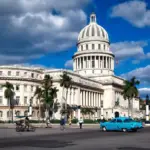
“When is the Best Time to Visit Vietnam and Cambodia? The optimal time to explore the captivating landscapes of Vietnam and Cambodia depends on the distinct seasonal patterns in each country. For Vietnam, the period from October to April is generally considered ideal, encompassing the cool and dry seasons. In northern regions like Hanoi and Halong Bay, this timeframe offers comfortable temperatures. Central destinations such as Hue and Hoi An are best visited from February to August, while the southern areas, including Ho Chi Minh City, are favorable from December to April. Meanwhile, in Cambodia, the months between November and March constitute the peak dry season, offering pleasant weather for exploring Phnom Penh, Siem Reap with its iconic Angkor Wat, and Battambang. Despite regional variations, it’s crucial to consider factors like crowd preferences and the possibility of occasional tropical storms, particularly during the typhoon season from June to November.”
the basic of Vietnam and Cambodia?”

Embarking on a journey to Vietnam and Cambodia is like stepping into a vibrant canvas painted with rich cultural tapestries, ancient wonders, and natural splendors. However, to truly appreciate the magic of these Southeast Asian gems, timing is key. In this four-part series, we’ll guide you through the nuances of when to visit Vietnam and Cambodia for an unforgettable experience.
Vietnam, with its elongated geography, boasts a climate that varies significantly from the north to the south. Understanding the distinct weather patterns in different regions is crucial for planning a trip that aligns with your preferences and interests.
Northern Vietnam: Seasons in Hanoi and Beyond

The northern region, including the capital city Hanoi, experiences four distinct seasons. Spring (February to April) brings blooming flowers and mild temperatures, making it an ideal time for exploring the historic streets of Hanoi and trekking in the Sapa region. Summer (May to August) can be hot and humid, with occasional rain showers. Autumn (September to November) charms visitors with cool weather and clear skies, while winter (December to January) can be chilly, especially in the mountainous areas.
If you’re drawn to the cultural festivities and vibrant atmosphere, consider visiting during Tet, the Vietnamese New Year, which usually falls in January or February. However, be prepared for crowded streets and higher accommodation prices.
Central Vietnam: Navigating the Contrasts

Central Vietnam, encompassing cities like Hue and Hoi An, experiences a unique weather pattern. While the coastal areas enjoy a tropical climate, the mountainous regions can be cooler. Planning your visit between February and April ensures pleasant weather and the chance to witness festivals like Hue Festival and Hoi An Lantern Festival.
The months from September to November are another favorable window, with milder temperatures and lower chances of rainfall. However, keep in mind that typhoons can occasionally affect this region, especially from September to December.
Southern Vietnam: Chasing the Sun

The southern part of Vietnam, including Ho Chi Minh City and the Mekong Delta, dances to a different climatic beat. Embracing a tropical climate, this region has two distinct seasons: the dry season (December to April) and the wet season (May to November).
For sun-seekers and outdoor enthusiasts, the dry season is the ideal time to explore the bustling streets of Ho Chi Minh City, cruise the Mekong Delta, and relax on the pristine beaches of Phu Quoc. However, be mindful of the higher temperatures during this period.
In contrast, the wet season brings lush landscapes and occasional afternoon showers. While the rain can disrupt outdoor activities, it also transforms Vietnam into a green paradise, offering a unique perspective for those willing to embrace the weather.
Understanding Vietnam’s diverse climate is the first step toward planning a trip that aligns with your preferences. In next we’ll delve into the intricate tapestry of Cambodia’s weather, completing the picture for an unforgettable Southeast Asian adventure.
Cambodia’s Weather Rhythms: Decoding the Ideal Seasons
As we continue our exploration into the optimal times to visit Vietnam and Cambodia, unravels the weather intricacies of Cambodia, providing valuable insights for planning your journey through this captivating land.
Cambodia: A Land of Temples and Tropical Charms

Cambodia, renowned for its ancient temples, vibrant culture, and warm hospitality, experiences a tropical climate similar to many Southeast Asian countries. Understanding the distinct wet and dry seasons is essential to curate an itinerary that aligns with your travel aspirations.
Dry Season (November to April): The Temple-Exploration Window

The dry season, spanning from November to April, is considered the best time to visit Cambodia. During these months, the weather remains relatively cool, and rain showers are infrequent. This is the ideal window for exploring Cambodia’s iconic Angkor Wat and other ancient temples without the hindrance of heavy rainfall.
The period between November and February witnesses cooler temperatures, making it particularly comfortable for extended temple explorations. However, be prepared for larger crowds, especially around popular sites like Angkor Wat.
Wet Season (May to October): Nature’s Rejuvenation

The wet season in Cambodia, from May to October, is characterized by higher temperatures and regular afternoon rain showers. While the humidity can be intense, the landscapes transform into a lush green paradise, offering a different perspective on Cambodia’s natural beauty.
Despite the rain, the wet season has its own allure. The crowds thin out, allowing for a more intimate experience at popular tourist sites. It’s also an excellent time for witnessing the vibrant rural life along the Tonle Sap Lake and exploring less-traveled regions.
Festivals and Events: Adding a Cultural Flair

Understanding Cambodia’s festival calendar can add a cultural dimension to your visit. The Water Festival, celebrated in November, marks the reversal of the flow of the Tonle Sap River and is a time of lively boat races and celebrations. Pchum Ben, or Ancestors’ Day, is another significant festival in September, where Cambodians pay respects to their ancestors.
Combining Vietnam and Cambodia: Finding the Synchronicity

To maximize your Southeast Asian adventure, consider aligning your visit to Vietnam and Cambodia during the overlapping dry seasons. This strategic planning allows you to explore both countries with favorable weather conditions, enhancing your overall travel experience.
we’ll delve into the shoulder seasons and specialized interests, offering a comprehensive guide to tailoring your journey based on specific preferences and activities. Whether you seek cultural immersion, outdoor adventures, or a bit of both, understanding the nuances of each season is the key to unlocking the full potential of your trip.
Tailoring Your Journey: Shoulder Seasons and Specialized Interests
In the intricate tapestry of planning your visit to Vietnam and Cambodia, Part 3 unravels the nuances of shoulder seasons and specialized interests. Whether you’re a culture enthusiast, an outdoor adventurer, or someone seeking a bit of both, these considerations will help you tailor your journey for an experience that resonates with your passions.
Shoulder Seasons: The Sweet Spot Between Extremes
Shoulder seasons, the transitional periods between the wet and dry seasons, offer a delightful compromise for those seeking a balance of favorable weather and fewer crowds.
Vietnam’s Shoulder Seasons:

Late April to June and September to November are considered shoulder seasons in northern Vietnam. During these times, you can enjoy milder temperatures and witness the landscapes in transition, with lush greenery and blooming flowers.
Cambodia’s Shoulder Seasons:
The months of May to early June and September to October mark Cambodia’s shoulder seasons. While there might be occasional rain showers, the crowds are thinner, creating a more intimate setting for exploring temples and experiencing local culture.
Outdoor Adventures: Finding the Thrills
If your heart yearns for outdoor adventures, understanding the best seasons for specific activities is crucial.
Vietnam’s Adventure Window:

For trekking enthusiasts, the dry months from October to April are ideal for exploring the mountainous landscapes of Sapa and Dalat. Water-based activities like cruising in Halong Bay are best enjoyed during the dry season.
Cambodia’s Adventure Window:
The dry season in Cambodia, particularly from November to March, is perfect for outdoor adventures like hiking, biking, and exploring the countryside. The cooler temperatures enhance the experience of activities around Siem Reap and Phnom Penh.
Cultural Immersion: Festivals and Local Experiences
Immersing yourself in the local culture adds a layer of authenticity to your journey. Understanding the festival calendar and local events is key to experiencing the vibrant tapestry of Vietnam and Cambodia.
Vietnam’s Cultural Highlights:

Tet, the Vietnamese New Year, is a cultural extravaganza celebrated in late January or early February. While it can be crowded, it offers a unique insight into Vietnamese traditions.
Cambodia’s Cultural Highlights:
The Water Festival in November is a vibrant celebration with boat races and cultural performances, providing a captivating glimpse into Cambodia’s traditions.
Combining Interests: Crafting Your Perfect Itinerary
Crafting the perfect itinerary involves weaving together your interests seamlessly. Consider combining your cultural explorations with outdoor adventures during the shoulder seasons to strike a harmonious balance.
In the final part of our series, we’ll provide a comprehensive summary, offering a month-by-month guide to help you pinpoint the best time for your visit based on your preferences. From the bustling streets of Hanoi to the ancient temples of Angkor Wat, understanding the seasonal rhythms unlocks the full spectrum of experiences awaiting you in Vietnam and Cambodia.
Crafting Your Perfect Journey: A Month-by-Month Guide and FAQs
As we conclude our exploration of the best times to visit Vietnam and Cambodia, Part 4 provides a comprehensive month-by-month guide to help you craft the perfect itinerary based on your preferences. Additionally, we’ll address common questions to ensure you embark on your Southeast Asian adventure with confidence.
Month-by-Month Guide: Navigating the Seasons
January to March:
Vietnam: Experience the festive atmosphere of Tet in January or February. The weather is cool and pleasant in the north, making it an excellent time for cultural exploration.
Cambodia: The dry season is in full swing, offering ideal conditions for exploring temples like Angkor Wat.
April to June:
Vietnam: Northern regions enter their shoulder season, providing milder temperatures and lush landscapes. Central Vietnam experiences pleasant weather.
Cambodia: Shoulder season continues, offering a balance between fewer crowds and reasonable weather.
July to August:
Vietnam: Central and southern regions are in the midst of their summer, with warm temperatures. The north experiences occasional rain.
Cambodia: The wet season begins, bringing lush greenery but occasional rain showers.
September to November:
Vietnam: The north transitions to its shoulder season, while the south enjoys the end of the rainy season. Central Vietnam experiences a pleasant autumn.
Cambodia: The wet season starts to recede, creating a beautiful backdrop for temple exploration.
December:
Vietnam: The north may experience winter chill, while central and southern regions enjoy dry and pleasant conditions.
Cambodia: The dry season begins, offering favorable weather for temple visits and outdoor activities.
FAQs: Deciding When is the Best Time to Visit Vietnam and Cambodia?
Is it possible to visit both Vietnam and Cambodia in one trip?
Absolutely! Planning your visit during the overlapping dry seasons (November to April) allows you to explore both countries seamlessly.
Are there any festivals I should be aware of?
Tet in Vietnam (January or February) and the Water Festival in Cambodia (November) are significant cultural celebrations. While they offer unique experiences, be prepared for crowds and higher accommodation prices.
How can I avoid crowds at popular tourist sites?
Consider visiting during the shoulder seasons (April to June and September to November), when the weather is favorable, and crowds are thinner.
What activities are best suited for each season?
Outdoor activities like trekking are ideal during the dry seasons, while temple exploration is enjoyable year-round, with each season offering a unique perspective.






